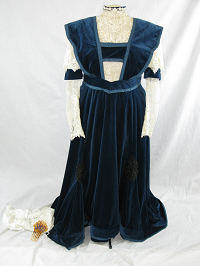1906
This velvet afternoon dress was copied from a picture of a 1906 gown in the Cincinnati Museum of Arts collection. The outfit defines the waist and shows the curve of the hips. Fashion decreed a small waist but large hips. Pads were used about and below the waist if needed. Black beaded medallions embellish the skirt and ribbon highlights the bodice. The bottom of the skirt has pleats to add to its circumference. The lace pinafore is worn over a lace blouse which has the high neck and ribbon bands.
While today most women have short hair, during the Edwardian age it was not cut. A woman's hair was something she treasured whether it was in good condition or not. They used home brewed products containing such ingredients as castor oil or petroleum jelly. The need for such products gave rise to companies such as Cody and L'Oreal. L'Oreal invented the first hair coloring and Charles Nestle invented the first permanent wave machine in 1905. It took 8 hours. Other forms of beauty culture being introduced at this time were electrolysis, chin straps to cure a double chin, and "Trilene" tablets to reduce weight without a change of diet.
Through the years fashionable clothing has had a proper foundation which supported the human figure by pushing, pulling and padding it into the proper shape for each new design. Underclothes were given lyrical titles, drawers became knickers. The chemise developed into combinations. The rustle of silk is disappearing at this time in favor of flimsy cotton petticoats and not more than two were used. The top of one, if colored, was called an underskirt. Evening petticoats were more elaborate and fashioned of glazed silk with deep flounces, frills, pin tucks and ruching. Some even had pockets just above the flounce. With the introduction of slimmer skirts the pockets were necessary for evening. During the day the pocketbook had been reintroduced to carry your handkerchief, latch key and powder.
Click photo for detailed views.


